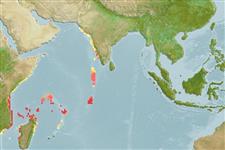Teleostei (teleosts) >
Gobiiformes (Gobies) >
Gobiidae (Gobies) > Gobiinae
Etymology: Trimma: Greek, trimma, -atos = something crushed (Ref. 45335); volcana: Named for Volcanus, Roman god of fire, referring to the amber-red spots on an earthy brown background that resemble numerous small, volcanic vents on a lava field, and is suggestive of the hot-spot origins of the Comores Islands; noun in apposition.
More on author: Winterbottom.
Environment: milieu / climate zone / depth range / distribution range
Ecology
Marine; demersal; depth range 0 - 24 m (Ref. 57687). Tropical
Western Indian Ocean: Tanzania, Mozambique and the Comores Islands.
Size / Weight / Age
Maturity: Lm ? range ? - ? cm
Max length : 1.9 cm SL male/unsexed; (Ref. 57687); 1.7 cm SL (female)
Dorsal spines (total): 7; Dorsal soft rays (total): 10 - 11; Anal spines: 9 - 11. Diagnosis: Characterized by having large spots on the head and body; moderate to well-developed interorbital and postorbital trenches; scales on the pectoral and pelvic fin bases, except on cheeks, opercles, or midline of the nape; a posterior nostril which is adnate to the eye; a fifth pelvic fin ray that is 80-9% of the fourth and is branched dichotomously twice (Ref. 57687).
Life cycle and mating behavior
Maturity | Reproduction | Spawning | Eggs | Fecundity | Larvae
Winterbottom, R., 2003. A new species of Trimma (Gobiidae) from the western Indian Ocean. aqua, J. Ichthyol. Aquat. Biol. 7(1):9-12. (Ref. 57687)
IUCN Red List Status (Ref. 130435: Version 2024-1)
Threat to humans
Harmless
Human uses
Fisheries: of no interest
Tools
Special reports
Download XML
Internet sources
Estimates based on models
Preferred temperature (Ref.
123201): 26.9 - 28.9, mean 27.5 °C (based on 214 cells).
Phylogenetic diversity index (Ref.
82804): PD
50 = 0.5000 [Uniqueness, from 0.5 = low to 2.0 = high].
Bayesian length-weight: a=0.01023 (0.00477 - 0.02194), b=3.01 (2.83 - 3.19), in cm total length, based on LWR estimates for this (Sub)family-body shape (Ref.
93245).
Resilience (Ref.
120179): High, minimum population doubling time less than 15 months (Preliminary K or Fecundity.).
Fishing Vulnerability (Ref.
59153): Low vulnerability (10 of 100).
